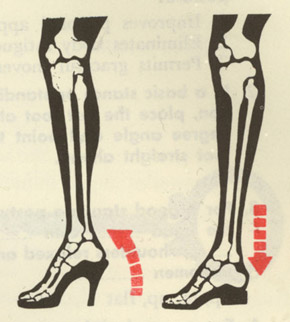
The ability to be hypnotised seems to be a distinct trait that is distributed among the population, like height or shoe size, in a “bell curve” or normal distribution: a minority of people cannot engage with any suggestions, a minority can engage with almost all, and most people can achieve a few.
The key word here is “engage”, as, contrary to popular belief, hypnosis cannot be used to make people do something against their will, even though the effects seem to happen involuntarily. If this seems paradoxical, a good analogy is watching a movie: you don’t decide to react emotionally to the on-screen story, but you can choose to turn away or disengage at any time. In other words, the effects of the film, just like hypnosis, require your active participation.
{ Observer | Continue reading }
photo { Sam Margevicius }
neurosciences |
July 26th, 2012

‘Many scientists don’t like to talk about shark sex,’ Juliet Eilperin writes in her entertaining study of sharks and their world. ‘They worry it will only reinforce the popular perception that these creatures are brutish and unrelenting.’ In as far as we understand the subject – only a few species have been observed mating – the business is ‘very rough’. Larger male sharks have to bite or trap the females to keep them around during courtship; marine biologists can tell when a female has been mating because her skin will be raw or bleeding. The process is so violent that, come the mating season, female nurse sharks will stay in shallow water with their reproductive openings pressed firmly to the sea floor. Otherwise they risk falling prey to roaming bands of males who ‘will take turns inserting their claspers in her’ (the clasper is the shark version of a penis, found in a pair behind the pelvic fins). A litter of fifty pups will have anything from two to seven fathers.
But the reproductive story gets rougher still. A number of shark species go in for oophagy, or uterine cannibalism. Sand tiger foetuses ‘eat each other in utero, acting out the harshest form of sibling rivalry imaginable’. Only two babies emerge, one from each of the mother shark’s uteruses: the survivors have eaten everything else.
{ London Review of Books | Continue reading }
animals |
July 26th, 2012

They might say that sex between people who are in love is special (maybe even sacred), but they also know sex is part of the partnership of getting through life together and has to be considered pragmatically as well. Even people in love do not have identical physical and emotional needs, with the result that sex takes different forms and means more or less on different occasions. […]
Part of the mythology of love promises that loving couples will always want and enjoy sex together, unproblematically, freely and loyally. But most people know that couples are multi-faceted partnerships, sex together being only one facet, and that those involved very often tire of sex with each other. Although skeptics say today’s high divorce rate shows the love-myth is a lie, others say the problem is that lovers aren’t able or willing to do the work necessary to stay together and survive personal, economic and professional changes. Some of this work may well be sexual. In some partnerships where the spark has gone, partners grant each other the freedom to have sex with others, or pay others to spice up their own sex lives (as a couple or separately). This can take the form of a polyamorous project, with open contracts; as swinging, where couples play with others together; as polygamy or temporary marriage; as cheating or betrayal; or as paying for sex. […]
Many people, not just professional sex workers, know that the work of sex can mean allowing the other to take an active role and assuming a passive one as well as taking the active role or switching back and forth. Sometimes people do what they already know they like, and sometimes they experiment. Sometimes people don’t know what they want, or want to be surprised, or to lose control.
For some critics, the possession of money by clients gives them absolute power over workers and therefore means that equality is impossible.
{ Jacobin | Continue reading }
photo { Tim Geoghegan }
economics, ideas, relationships, sex-oriented |
July 26th, 2012

Single-Nostril Navigational Reliance in Pigeons
We recorded the flight tracks of pigeons with previous homing experience equipped with a GPS data logger and released from an unfamiliar location with the right or the left nostril occluded. The analysis of the tracks revealed that the flight path of the birds with the right nostril occluded was more tortuous than that of unmanipulated controls. Moreover, the pigeons smelling with the left nostril interrupted their journey significantly more frequently and displayed more exploratory activity than the control birds, e.g. during flights around a stopover site.
[…]
How Randomly Selected Legislators Can Improve Parliament Efficiency
Democracies would be better off if they chose some of their politicians at random. That’s the word, mathematically obtained, from the Catanians’ extension of their random research, using insights they gleaned from the much earlier stupidity work by Cipolla.
Parliamentary voting behavior echoes, in a surprisingly detailed mathematical sense. Cipolla had sketched this in the “Basic Laws of Human Stupidity.” Cipolla gave an insulting, yet possibly accurate, description of any human group: “human beings fall into four basic categories: the helpless, the intelligent, the bandit, and the stupid.” Pluchino, Rapisarda, Garofalo and their colleagues base their mathematical model partly on this fourfold distinction.
{ Annals of Improbable Research | full issue }
photo { Daniel Seung Lee }
birds, ideas, science |
July 26th, 2012
photogs, visual design |
July 25th, 2012

Self-citing is often frowned upon, being considered (and sometimes is) vanity, egotism or an attempt in self-advertising. However, everyone self-cite because sooner or later, everyone builds upon previous findings. “Given the cumulative nature of the production of new knowledge, self-citations constitute a natural part of the communication process.” (Costas et al., 2010).
The argument whether citation analysis should include self-citation has been going on since the early days of citation analysis and is still ongoing. Early citation studies tended to exclude self-citation, but today’s Journal Impact Factor (JIF) includes them. […]
We’ve seen that self-citation can pay off at the journal level, but what about individual authors? Fowler and Aksnes (2007) did another research on the Norwegian database, but this time it was author rather than publication oriented. The percentage of author self-citation was rather low – 11% – but every self-citation yield, on average, 3.65 citations from others in 10 years. Fowler and Aksnes concluded that “self-citation advertises not only the article in question, but the authors in question.”
{ Scientific American | Continue reading }
ideas |
July 25th, 2012

In general, the more different is the new environment from the old, the better it is to start over. Rigid things are fragile, in that they break when you try to bend them far.
This suggests that designed systems tend to get irreversibly fragile as they adapt to specific environments. When context changes greatly, it is usually easier to build new systems from “scratch,” than to un-adapt systems designed for other contexts. Software tends to “rot“, for example. […]
Today I’m focused on this being bad news for the feasibility of immortality, at least for human-like creatures. You see, our minds seem designed to adapt to the environment in which we grow up, via youthful plasticity transitioning to elderly rigidity. For example, we are great at learning languages when young, and terrible when old. We are similarly receptive when young to new ways to categorize and conceive of things, but once we have often used particular ways, we find it harder to understand and use alternatives.
The brains of most animals peak in functionality during their key reproductive years, and do worse both before and after. Short lived animals peak sooner than long lived animals. Some of the early rise is due to learning, and some of later decline is due to the decline of individual cells and connections. Some of this pattern may even be due to an explicit plan to turn up some dials on plasticity early on, and then turn down those dials later. But I think another important part of this rise and fall is due to a general robust tendency for adapted systems to slide from plasticity to rigidity.
{ Overcoming Bias | Continue reading }
photo { Joel Meyerowitz }
ideas, photogs |
July 25th, 2012

Confucianism is not a conceptual monolith but rather has a variety of traditions, versions and forms including imperial, reform, elite, merchant-house, and mass Confucianism. Just as Confucianism is multidimensional, democracy is also multifaceted including liberal, developmental, social, deliberative, and republican conceptions of democracy.The relationships between democracy and Confucianism therefore must be multiple and complex.
{ SSRN | Continue reading }
artwork { Sylvan Lionni }
ideas |
July 25th, 2012

Ryan Holiday could be called an “expert.” As head of marketing for American Apparel, an online strategist for Tucker Max, and self-styled “media manipulator,” he can talk social media and modern advertising with the best of them – he’s done so both online and in print on countless occasions. […]
On Reuters, he became the poster child for “Generation Yikes.” On ABC News, he was one of a new breed of long-suffering insomniacs. At CBS, he made up an embarrassing office story, at MSNBC he pretended someone sneezed on him while working at Burger King. At Manitouboats.com, he offered helpful tips for winterizing your boat. The capstone came in the form of a New York Times piece on vinyl records — naturally, Holiday doesn’t collect vinyl records.
{ Forbes | Continue reading }
artwork { Béatrice Cussol }
media, scams and heists |
July 25th, 2012

Never before in human history have so many people been on the move […] airfare, new technologies […] space and time have never been so compressed. […] Migrants are no longer just ‘migrants’ but have become ‘transnationals’ maintaining links between their country of origin, their current country, and, not unusually, other countries where they have spent time.
The cool imagery of the new transnationalism is sometimes ruptured by analysts pointing out how class and race constrain or enable different forms of transnationalism. […] Qureshi starts with the observation that, according to the literature, Pakistanis in Britain have
developed a ‘transnational ethnic world’ that is continually reproduced through longdistance phone calls, frequent return visits and holidays, the consumption of circulating goods and media products, exchanges of gifts, philanthropic investments in schools, hospitals and humanitarian projects in Pakistan and so forth (Qureshi 2012, p. 2).
Descriptions of a British-Pakistani transnational world such as these are based on normalized assumptions of healthy, materially secure migrants whose first priority is their cultural and ethnic identity. The chronically ill men the researcher encountered in East London told a different story, a story where their ailing bodies tied them to London. […]
Their lack of financial resources has tied them to London and has made practices of transnationalism difficult: for instance, ‘cheap’ airfares are not ‘cheap’ to them but involve years of budgeting ahead and borrowing; their disability coupled with the fact that Pakistanis back home see them as ‘rich’ and expect bribes and presents at every turn, makes movement in Pakistan difficult and unpleasant for them; and, phone cards, the so-called ‘social glue’ of transnationalism, have to be carefully rationed.
{ Language on the move | Continue reading }
photo { Daniel Seung Lee }
science, within the world |
July 25th, 2012

Does infinity exist?
This is a surprisingly ancient question. It was Aristotle who first introduced a clear distinction to help make sense of it. He distinguished between two varieties of infinity. One of them he called a potential infinity: this is the type of infinity that characterises an unending Universe or an unending list, for example the natural numbers 1,2,3,4,5,…, which go on forever. These are lists or expanses that have no end or boundary: you can never reach the end of all numbers by listing them, or the end of an unending universe by travelling in a spaceship. Aristotle was quite happy about these potential infinities, he recognised that they existed and they didn’t create any great scandal in his way of thinking about the Universe.
Aristotle distinguished potential infinities from what he called actual infinities. These would be something you could measure, something local, for example the density of a solid, or the brightness of a light, or the temperature of an object, becoming infinite at a particular place or time. You would be able to encounter this infinity locally in the Universe. Aristotle banned actual infinities: he said they couldn’t exist. This was bound up with his other belief, that there couldn’t be a perfect vacuum in nature. If there could, he believed you would be able to push and accelerate an object to infinite speed because it would encounter no resistance. […]
But in the world of mathematics things changed towards the end of the 19th century when the mathematician Georg Cantor developed a more subtle way of defining mathematical infinities. Cantor recognised that there was a smallest type of infinity: the unending list of natural numbers 1,2,3,4,5, … . He called this a countable infinity. […] This idea had some funny consequences. For example, the list of all even numbers is also a countable infinity. Intuitively you might think there are only half as many even numbers as natural numbers because that would be true for a finite list. But when the list becomes unending that is no longer true.
{ Plus | Continue reading | Other Plus articles on the subject of infinity }
photo { Thobias Fäldt }
ideas, mathematics |
July 24th, 2012

Every sect of Buddhism maintains that it is a religion of compassion and nonviolence. Throughout its history, however, Buddhism has occasionally been embroiled in warfare and military campaigns. Zen Buddhism in particular has managed to find its way into various military arts. From its incorporation into the Shaolin Monastery and the impact on the Japanese samurai to its absorption into the curriculum of several martial arts, Zen and fighting have come to be seen as closely related. This is due to certain characteristics of its doctrine as well as its practice. In fact, fighting is not entirely absent from Zen texts and literature. There are stories and kōans which depict amputations, encounters between samurai, or some kind of confrontation. Fighting, in the sense of an inner struggle is also present. […]
The objective of this examination is to draw parallels between Zen meditation and martial arts training and explore the reasons why Zen’s core philosophical doctrine and meditative practice can be integrated seamlessly into the martial arts.
{ SSRN | Continue reading }
fights, ideas, psychology |
July 24th, 2012

They found that people high in the psychological attribute called attachment anxiety (a tendency to worry about the proximity and availability of a romantic partner) responded to memories of a relationship breakup with an increased preference for warm-temperature foods over cooler ones: soup over crackers. Subjects low in attachment anxiety — those more temperamentally secure — did not show this “comfort food” effect. […]
The fact that individual differences in a relationship-oriented trait (attachment anxiety) are related to a person’s sensitivity to unconscious temperature-related cues speaks to the “under the hood” unconscious mingling that occurs between our social perceptual system and our temperature perception system. Though people predisposed to worry about their relationships seem to be more sensitive to these cues, we are all predisposed to the blurring of different types of experience. Similar recent experiments have demonstrated, for example, that briefly holding a warm beverage buoys subsequent ratings of another’s personality, that social isolation sensitizes a person to all things chilly, that inappropriate social mimicry creates a sense of cold, and that differences in the setting of the experimental lab’s thermostat leads test subjects to construe social relationships differently.
{ Scientific American | Continue reading }
photo { The Sydney Justice & Police Museum | Mugshots from the 1920s }
psychology, temperature |
July 24th, 2012

{ Three satellites found that 97 percent of Greenland — the land mass second only to Antarctica for its volume of ice — underwent a thaw never before seen in 33 years of satellite tracking, NASA reported Tuesday. Satellite experts at first didn’t trust their readings, especially since they showed an incredible acceleration. Over four days, Greenland’s ice sheet — which covers 683,000 square miles – went from 40 percent in thaw to nearly entirely in thaw. | NBC | Continue reading | Thanks Samantha }
climate, incidents, water |
July 24th, 2012

We experience the world serially rather than simultaneously. A century of research on human and nonhuman animals has suggested that the first experience in a series of two or more is cognitively privileged.
{ PLoS ONE | Continue reading }
It’s a long-standing truism. Plaintiffs have an edge with the jury because they go first. The defense has to convince those same jurors that the plaintiff story just isn’t true. […]
Researchers performed studies wherein they show that what we see first is what we most often prefer. Whether it was human salespeople, bubblegum, or which of two violent criminals was more worthy of parole–the photo we see first is the one we prefer to either purchase a vehicle from, chew, or deem more worthy of parole. Are we really that simple-minded? Unfortunately, it would appear the answer is yes.
But this tendency is only reliable when we are forced to make our decisions quickly. When we are given time to consider and ponder our choices–like juries have–we don’t tend to choose the first item brought to our attention, but rather the most recent.
{ Keene Trial | Continue reading }
photo { George W. Gardner }
law, psychology |
July 23rd, 2012

When you walk through the self-help aisle of any bookstore, you are likely to see plenty of books based on the notion that positive thinking is the key to getting what you want. The message is clear: if you want to achieve something, just keep telling yourself “I can!” and envision yourself accomplishing your goals. Success will surely come your way.
Not so, says years of psychological research. Certain kinds of positive thoughts, known in the research as fantasies, can actually be detrimental to performance.
{ Psych Your Mind | Continue reading }
psychology |
July 23rd, 2012

Bioengineers have made an artificial jellyfish using silicone and muscle cells from a rat’s heart. The synthetic creature, dubbed a medusoid, looks like a flower with eight petals. When placed in an electric field, it pulses and swims exactly like its living counterpart.
“Morphologically, we’ve built a jellyfish. Functionally, we’ve built a jellyfish. Genetically, this thing is a rat,” says Kit Parker, a biophysicist at Harvard University in Cambridge, Massachusetts, who led the work.
{ Nature | Continue reading | NERS/Discover }
artwork { Trevor Brown }
jellyfish, science, technology |
July 23rd, 2012

Cinderella Castle is the worldwide-recognized icon of the Disney empire. Physical representations of it stand at the center of two Disney Parks: Walt Disney World in Florida, and Tokyo Disneyland. Assuming it were an actual fortress, how would you take it?
A ground must be chosen in which you can quickly secure a foothold into the Magic Kingdom. This position must be easily accessible for the invasion force, provide cover and concealment for the troops and give strategic advantage once taken while depriving the enemy of the same. For this mission, I choose the area outside the tracks, between Tomorrowland and Main Street USA. Consideration must be taken to ensure we are not spotted by the monorail.
{ Jonathan Kirk Davis, Sergeant of Marines/Quora | Continue reading }
related { Macaroni Combat films }
fights, showbiz |
July 23rd, 2012
economics, photogs |
July 23rd, 2012

Throughout the past several decades, the United States has seen a steady increase in women’s status. Overt sexism is on the decline and women are becoming increasingly well represented in prestigious, high-paying jobs. Despite these welcome improvements, many gender-typed norms related to heterosexual courtship and marriage have remained remarkably stable over time.
For example, it is relatively rare for women to propose marriage to men. In addition, the majority of women still take their husband’s last name upon marriage, whereas few men consider taking their wife’s last name. People typically adhere to marriage-related norms in the name of tradition or romance.
However, there is also reason to believe that these norms are subtle manifestations of sexism within heterosexual romantic relationships. In the present study, we sought to establish an empirical connection between women’s and men’s marriage- tradition preferences and their level of sexism. We began by examining participants’ personal preferences regarding marriage proposals and marital name changes. We then tested whether endorsing benevolent sexism was predictive of holding traditional marriage preferences.
{ Journal of Adolescent Research | PDF }
painting { Gérard Gasiorowski, L’Approche, Des Limites de ma pensée, 1970 }
genders, relationships |
July 22nd, 2012






















